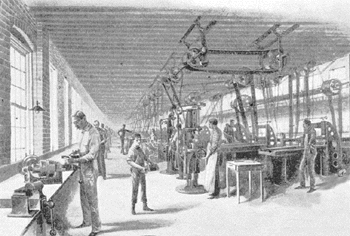
Toolroom of the Indiana Bicycle Company, 1896.
Indiana Bicycle Company, Waverly
(Indianapolis, 1896), 5.
For most individuals, walking or using a horse--with or without a wheeled vehicle--were the standard transportation options on land until the late nineteenth century, even after railroads came in the mid-1800s.
In 1876, Philadelphia held an exposition in honor of the centennial of the United States. It was here that the English high-wheeler, or ordinary, was first introduced to the American public. It was not long thereafter that the bicycle mania gripped consumers.
Robert Smith, a modern historian, has written of
the impact of the bicycle on American life, an influence far transcending its use for mere sport . . . . especially in the areas of technological advances and alterations of the transportation system (x).
According to one contemporary author, Maria Ward,
The usefulness of the bicycle begins where that of the railroad ceases, for it connects and opens districts of country that the railroad has not reached (2).
Smith asserts that
the old concepts of social morality and proper conduct were undermined by the freedom conferred upon those who rode the wheel. As a result, a considerable part of American society had to re-evaluate its old ideas (112-13).
For the first time, more people could go where and when they wanted, if they had enough money to purchase a bicycle. Early bicycles were expensive, and, for the most part, only the wealthy could afford them. Others, including women and children, got to ride as mechanical improvements were made and prices came down.
Social restrictions were relaxed. Men and women met, talked, and even rode together, without the watchful eye of a chaperone. The healthful benefits of riding a bicycle were promoted.
The bicycle also set the stage for the coming automobile. Innovative manufacturing and marketing, safety accessories, insurance, service clubs, good roads movement, and road maps and signage, for example, were first developed with the bicycle.
General source: Smith, Social History.
